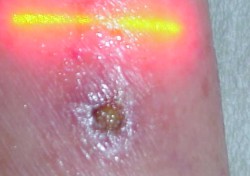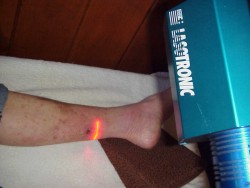Introduction to Low Level Laser Therapy (LLLT)
Dr. Z is currently conducting patient funded, clinical studies in Low
Level Laser Therapy (LLLT). At this time, Low Level Laser Therapy
(LLLT) is not approved for general use by the FDA. Low level lasers
are considered investigational devices. However, more than ten years
ago, the FDA made a ruling that Low Level Lasers are considered Non-Significant
Risk (NSR) devices. In other words, they are safe when used properly.
Dr. Z
has obtained approval from an Institutional Review Board (IRB)
to conduct Low Level Laser Therapy (LLLT) studies at his office in Nevada
City, Ca. This IRB approval meets the FDA requirements for Investigational
Device Exemption (IDE) and the use of NSR devices on human patients.
Low Level Laser (LLLT):
The Aladdin's Lamp of the 20th Century?
It was in the year in 1966. Dr. Endre Mester, professor of
surgery at the Semmelweis Hospital in Budapest, received a new and
an exciting device: the Ruby Low Level Laser. He had been given funds in
order to research if light from the Low Level Laser could be used to combat cancer.
He conducted a series of experiments, first on cell cultures, then on
rats, in order to ascertain that Low Level Laser Therapy (LLLT) light--this new and unknown type
of light--would not give rise to dangerous or unexpected results. He
removed (shaved) the fur from the back of a number of rats. He then
applied different dosages of Low Level Laser lights to ½ of the shaved area. The
other half was left untreated, for comparison reasons. With small Low Level Laser light
dosages nothing happened. With larger Low Level Laser light dosages the fur grew back faster
on the treated half: the Low Level Laser light had a stimulating affect! With
even larger dosages this stimulating effect disappeared, and with even
higher dosages the opposite effect occurred: the fur on the untreated
half re-grew faster. An inhibitory effect was obtained.
The research
group under a Dr. Mester conducted several experiments. With a new group
of rats a surgical wound was created on each side of the body. Only
one wound was treated with Low Level Laser Therapy (LLLT) light, the other wound was left untreated.
A certain dosage of Low Level Laser Therapy (LLLT) light stimulated wound healing, while a significantly
higher dosage of Low Level Laser Therapy light proved to inhibit wound healing. The results
of this research were published in 1967 in Hungarian, but remained largely
unnoticed in the Western countries.
Today,
30 years later, nearly 2000 different investigations from over
eighty countries about the effect of Low Level Laser Therapy (LLLT) on humans and animals have been published in the medical literature.















